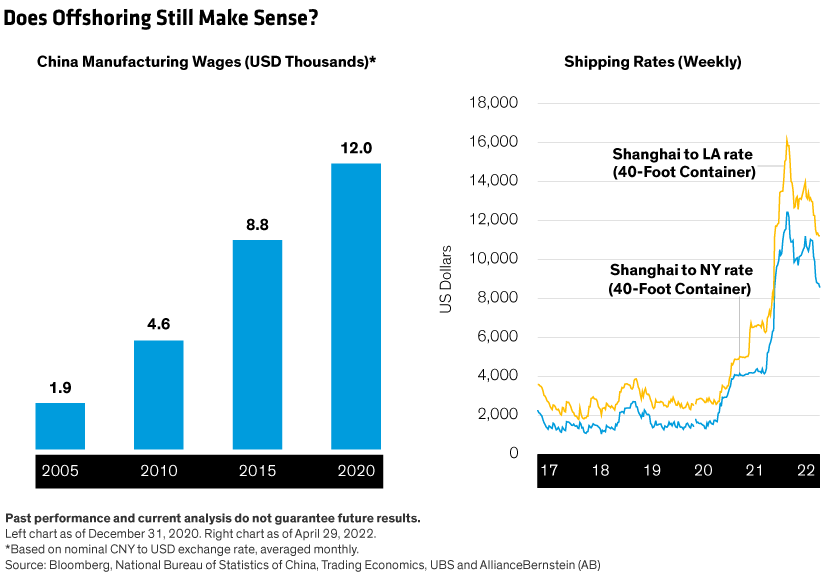Written by: Erik Turenchalk and James MacGregor
Many companies are rethinking supply chains amid disruptions from the war in Ukraine and the pandemic. Equity investors must decipher which companies can adapt their processes to compete in a less globalized world.
Solving the supply chain problem is one of the biggest operational challenges facing companies after decades of globalization. Beyond the geopolitical risks, the business benefits of offshoring are coming into question. Offshore wages are rising (Display, left), while increasing automation is reducing the higher cost of domestic labor needed to manufacture closer to home. Shipping costs have skyrocketed (Display, right). And for US companies, domestic energy costs are much cheaper than abroad, while tariffs stemming from US-China trade disputes have added another layer of costs.

These trends are eroding the economic rationale for offshoring. Offshoring generally makes sense if a company can produce a good for at least 20% less than in its home country. As companies and investors reassess the trade-offs, they may also demand a greater offshore discount to compensate for escalating supply chain risks. Here are some of the key issues equity investors should watch to find companies that are ahead of the reshoring curve.
Capex clues: How a company invests for the future can indicate whether it’s shifting production toward new regions to avert future disruption. In some industries, we’re seeing huge capital expenditures in manufacturing facilities to improve regional alignment with customers and revenue.
The semiconductor industry is among the leaders. Intel recently announced €29 billion of investments in new semiconductor manufacturing facilities in Germany and Ireland. It’s also spending $40 billion on new plants in Ohio and Arizona. Taiwan Semiconductor Manufacturing is investing $19 billion in Japan and Arizona, with further investments expected in Germany. Spending by multinationals on this scale will fuel earnings in other areas, such as steel and construction equipment, creating opportunities for investors who spot the beneficiaries early.
Diversifying suppliers: Some companies are facing dramatic supply problems because of the war in Ukraine. For example, Boeing and Airbus are scrambling for new sources of finished titanium, used for airplane structures and engines, because a Russian company is a dominant global supplier. Western titanium suppliers are well positioned to benefit from this shift. Investors in aerospace companies should closely monitor these efforts to diversify supply, which are indicative of broader changes in the industry’s supply chain. Sourcing new supply quickly and at a reasonable cost could be a decisive factor in their ability to meet delivery deadlines and earnings expectations.
Balance-sheet shifts: Some companies plan to use cash flow to increase working capital and/or to build more inventory on balance sheets. This could create short-term headwinds to cash flow for manufacturers. On the other hand, we believe companies that facilitate the distribution of components and are integrated in supply chains will become more valuable. This trend is already visible. Some distributors across different industries have exceeded expectations in recent earnings reports, suggesting they are beginning to benefit from supply chain changes.
Management quality: Reconfiguring supply chains is a strategic challenge that requires initiative, innovation and the ability to balance increased short- and medium-term costs with long-term benefits. Management quality is essential for success, especially given that intangible factors could make a difference. Since labor costs are a big part of the puzzle, managers who build healthy corporate cultures will be advantaged in retaining highly valued staff.
Gauging companies on these issues requires an active investment approach, in our view. Equity investors must ask the right questions rather than simply relying on a company’s public statements. By engaging with management, investors can gain insight into a company’s strategic vision and influence decision-making. And in a market driven by short-term anxieties, investors with a long-term view can identify companies that are more likely to efficiently restructure supply chains and deliver superior return potential over time.
Related: A Brewing Commodities Crisis Could Push Up Shipping Costs Even More



